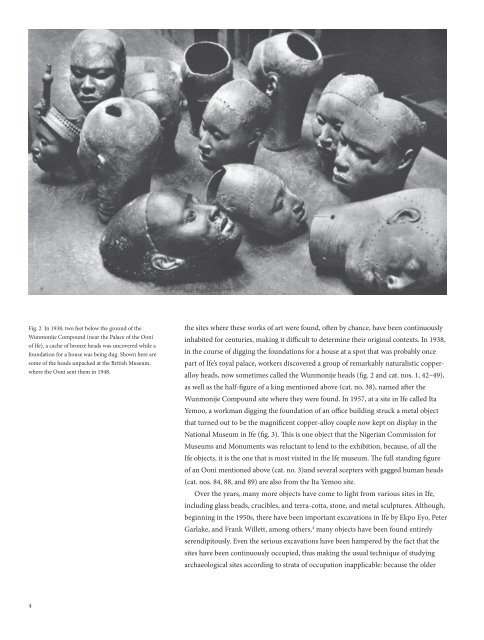The British Museum - Kingdom of Ife Sculptures from West Africa
Create successful ePaper yourself
Turn your PDF publications into a flip-book with our unique Google optimized e-Paper software.
Fig. 2 In 1938, two feet below the ground <strong>of</strong> the<br />
Wunmonije Compound (near the Palace <strong>of</strong> the Ooni<br />
<strong>of</strong> <strong>Ife</strong>), a cache <strong>of</strong> bronze heads was uncovered while a<br />
foundation for a house was being dug. Shown here are<br />
some <strong>of</strong> the heads unpacked at the <strong>British</strong> <strong>Museum</strong>,<br />
where the Ooni sent them in 1948.<br />
the sites where these works <strong>of</strong> art were found, <strong>of</strong>ten by chance, have been continuously<br />
inhabited for centuries, making it difficult to determine their original contexts. In 1938,<br />
in the course <strong>of</strong> digging the foundations for a house at a spot that was probably once<br />
part <strong>of</strong> <strong>Ife</strong>’s royal palace, workers discovered a group <strong>of</strong> remarkably naturalistic copperalloy<br />
heads, now sometimes called the Wunmonije heads (fig. 2 and cat. nos. 1, 42–49),<br />
as well as the half-figure <strong>of</strong> a king mentioned above (cat. no. 38), named after the<br />
Wunmonije Compound site where they were found. In 1957, at a site in <strong>Ife</strong> called Ita<br />
Yemoo, a workman digging the foundation <strong>of</strong> an <strong>of</strong>fice building struck a metal object<br />
that turned out to be the magnificent copper-alloy couple now kept on display in the<br />
National <strong>Museum</strong> in <strong>Ife</strong> (fig. 3). This is one object that the Nigerian Commission for<br />
<strong>Museum</strong>s and Monuments was reluctant to lend to the exhibition, because, <strong>of</strong> all the<br />
<strong>Ife</strong> objects, it is the one that is most visited in the <strong>Ife</strong> museum. <strong>The</strong> full standing figure<br />
<strong>of</strong> an Ooni mentioned above (cat. no. 3)and several scepters with gagged human heads<br />
(cat. nos. 84, 88, and 89) are also <strong>from</strong> the Ita Yemoo site.<br />
Over the years, many more objects have come to light <strong>from</strong> various sites in <strong>Ife</strong>,<br />
including glass beads, crucibles, and terra-cotta, stone, and metal sculptures. Although,<br />
beginning in the 1950s, there have been important excavations in <strong>Ife</strong> by Ekpo Eyo, Peter<br />
Garlake, and Frank Willett, among others, 4 many objects have been found entirely<br />
serendipitously. Even the serious excavations have been hampered by the fact that the<br />
sites have been continuously occupied, thus making the usual technique <strong>of</strong> studying<br />
archaeological sites according to strata <strong>of</strong> occupation inapplicable: because the older<br />
4

















